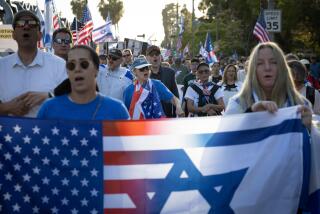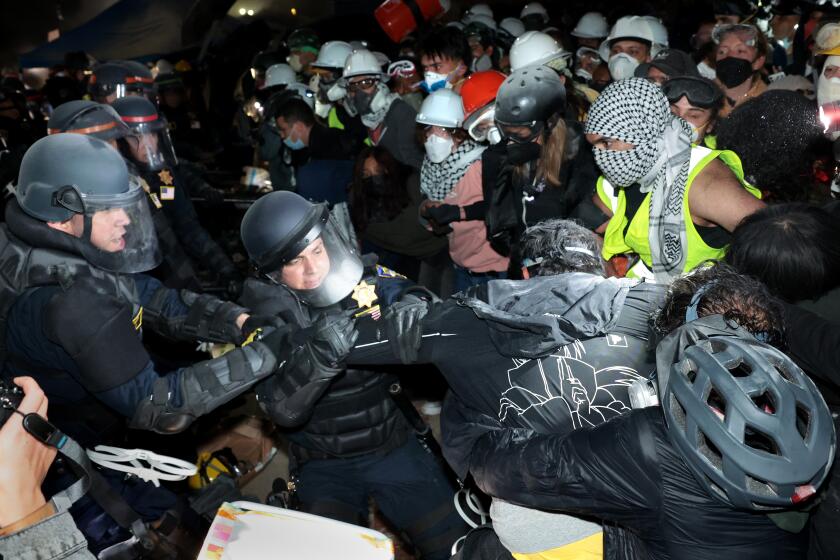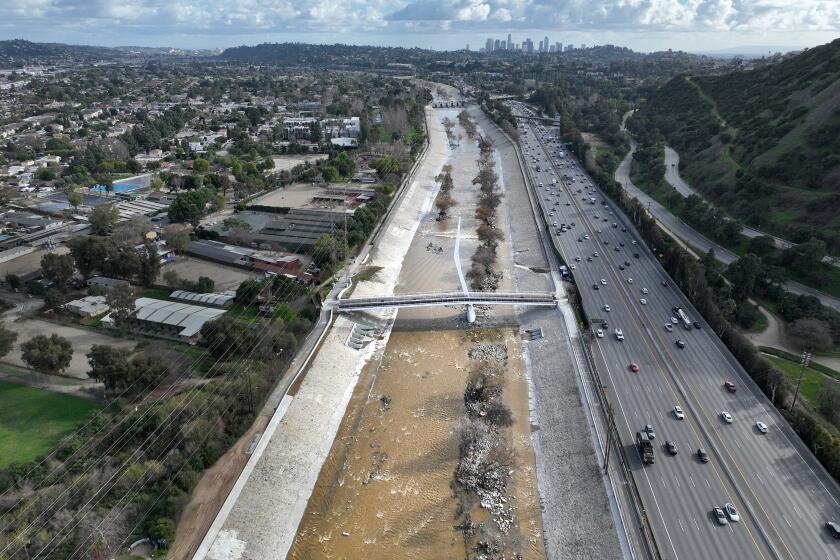‘Blitz Boom’ Town : War: Overnight, San Diego’s social fabric and its economy were remolded by the Pearl Harbor attack.
Barbara Ethel Schillreff opened the wooden window blinds the morning of Dec. 8, 1941, and found herself staring at a machine gun. During the night, five soldiers had planted the gun in the yard of her family’s ocean view home in La Jolla--aimed toward the sea, ready to fire on invaders.
For Schillreff and thousands of San Diegans, the war transformed their lives and their city virtually overnight. Workers and military personnel poured into San Diego, turning what had been a languid Navy town into a teeming industrial and military center.
For the record:
12:00 a.m. Dec. 2, 1991 For the Record
Los Angeles Times Monday December 2, 1991 San Diego County Edition Metro Part B Page 8 Column 1 Metro Desk 2 inches; 57 words Type of Material: Correction
City limits--A corrected version of a map that appeared in Sunday’s editions showing San Diego’s prewar city limits is reprinted above.
Prewar San Diego
The city of San Diego grew to 95.53 square miles with the Aug. 30, 1941, annexation of 143 acres in Talmadge Park. Today, the city covers 328.26 square miles. Mission Bay was not annexed from the county until 1951.
Source: San Diego city clerk’s office
“San Diego used to be more genteel,” said Schillreff, who was 20 when war broke out. “The streets used to be washed every day. No woman went to town without her hat and gloves on. All that business changed.”
The Japanese bombing of Pearl Harbor on Dec. 7, 1941, ignited a war that changed the world and redefined San Diego. It was an event that forever altered the social fabric of the city while remolding its economy. Now, 50 years later, the metamorphosis wrought during World War II has formed the city’s very foundation.
Before the war, “geraniums versus smokestacks” was the central controversy as officials battled over whether San Diego should continue as a tourist mecca or develop as an industrial base.
In those days, the city tipped toward tourism. But when war broke out, San Diego became host to military and defense contractors--the industry that, more than any other, defines San Diego today.
“From that moment--from Pearl Harbor--San Diego moved forward and it didn’t look back,” said Mary Scott, a researcher with the San Diego Aerospace Museum and author of “San Diego, Air Capital of the West.”
San Diego’s dizzying growth occurred in short--and often unplanned--order. The government sometimes installed entire neighborhoods of homes that had no interconnecting roads, food stores or services such as schools and trash collection.
It was not a mere boom but a “blitz boom”--a term from the time--which increased the military presence tenfold and practically doubled the city’s population in four years to about 400,000 by 1944.
As thousands of men enlisted, the complexion and gender of San Diego’s work force changed. For the first time, white women as well as minorities were pressed to work.
With women working, the very first generation of latchkey children emerged. The attention and the energy of the city were devoted to the war effort. And San Diego abruptly became a 24-hour metropolis, with movie theaters and activities remaining open day and night to accommodate those working swing shifts.
At recruiting stations, the lines snaked around the block. Boot camps at the Naval Training Center and the Marine Corps Recruit Depot were bursting with new recruits. MCRD, which customarily trained 10,000 recruits annually, suddenly started pushing men through the eight-week crash course at a rate of 100,000 per year.
Many of these young men--like Hollis Gillespie--hailed from the Midwest and had never before seen the ocean. Plenty of them vowed to one day return and make San Diego their home--a promise that some were able to keep.
“I had no training except as a wheat farmer and no chance at getting a job because there were no jobs,” Gillespie wrote in a 1979 letter to Cabrillo National Monument officials describing his stint at Fort Rosecrans. “The Army’s promise of three meals a day and a paycheck ($21 a month) made me a very patriotic and proud citizen.”
Most, like Gillespie, had enlisted--and were proud of it.
“Well, why not? I had just turned 21, the second youngest of a fatherless family of seven children who had just come through the world’s worst Depression and 11 years of drought and dust storms on a farm in Kansas,” wrote Gillespie, who was stationed at Fort Rosecrans, which he described as “a place where a lot of green country boys became men.”
The Japanese attack stunned San Diego, where people learned of Pearl Harbor from the radio, or sound trucks that sped through downtown, or from the screaming headlines of afternoon newspaper extras.
A few minutes before noon Sunday, Dec. 7, Mary Scott was listening to the radio in the living room of her family’s Talmadge home, when the broadcast was interrupted and the announcer told of the Japanese attack. Scott, then 9, ran into the kitchen, where her parents were drinking coffee with a neighbor. The three adults had turned ashen and Scott knew enough to be scared.
That afternoon, the family rushed to the store and stocked up on tins of Spam and canned beans. They also got a first aid kit and a bucket of sand that her parents hoped would douse any fire caused by a bomb striking their home.
“We were no longer just San Diego sitting here at the tip of California--we were part of something much bigger,” Scott remembered. “For a kid, it was so exciting. Children really had a place. You’d go gather aluminum, flatten tin cans--you were part of the war effort, too.”
But it was also terrifying. Night after night, Scott dreamed of Japanese bombs pounding and flattening the city.
San Diegans suddenly felt their own vulnerability, since the city itself was so poorly prepared for a coastal attack, while it seemed to be a key target.
For at least six months, residents and military officials believed the Japanese would continue pressing forward, striking the West Coast next. That common fear, mixed with patriotism, united the city as had no other war before--or since.
On Dec. 7, the city tried to brace itself against a possible attack. About 1,200 volunteers who served to spot enemy aircraft reported for duty. A steel net was placed across the entrance of the harbor in an effort to keep out enemy submarines and vessels. A hastily organized black-out that evening was only partly successful, since not everyone knew what was going on.
Military officials feared the Japanese would attack from the coast or inland, as the enemy crossed the Mexican border into the county’s isolated backcountry. At Camp Lockett in Campo, cavalry units--including two all-black units--stepped up their border patrols.
“World War II was a total war, it wasn’t like Vietnam or the Persian Gulf where everyone put in their 2 cents. You didn’t criticize the government, you did everything you could to aid the government,” said Howard Overton, chief ranger with Cabrillo National Monument and editor of the soon-to-be published “The Guns of Point Loma.”
“For the first six months, the whole West Coast was expecting an attack--it wasn’t if it happened, it was when it would happen,” Overton said. “There was a siege mentality in San Diego.”
The city was quickly wrapped tight with anxiety. Chinese residents began wearing a button in their lapel, indicating they were not Japanese. A whale washed ashore in La Jolla and it was mistaken for a Japanese submarine. Machine gun fire in the harbor was reported to Fort Rosecrans soldiers, who initially also believed it was gunfire.
“I looked and they were shooting in the water, the water was shooting up, I could see it. It looked like a machine gun firing but it was a school of whales when they blow. The major called back and asked: ‘Don’t you know the difference between machine gun fire and whales?’ ” remembered Cpl. George H. McGlothlin of the 19th Artillery stationed at Fort Rosecrans.
The city’s paranoia was not completely unfounded.
Twice, early in the war, Japanese submarines were spotted within firing range of San Diego, according to Richard Pourade’s historical account, “City of the Dream.” In fact, a submarine appeared along the coast, sailed north and hurled shells at Goleta, near Santa Barbara--the first to fall on U.S. land during the war.
After Pearl Harbor, San Diego’s small but prosperous Japanese community vowed its loyalty to the United States. But in the coming months, they were treated with increasing suspicion and hostility.
Finally, on April 8, 1942, 1,200 were forced to leave southern San Diego County for internment camps in Central California and Arizona. Most spent about four months living in horse stalls or temporary tar-paper barracks at the Santa Anita Racetrack in Arcadia, said Donald Estes, a history professor at San Diego City College. And on May 17, 1,000 Japanese-Americans living in North County were shipped to camps.
Most of the military men who descended on San Diego were not senior officers but young, green soldiers, Marines and sailors. In 1940, there were 10,855 military men stationed in San Diego--four years later, the military population leaped to 115,810.
The city opened its arms to the young servicemen. Families invited them in for home-cooked meals.
Initially, dances were held and college sorority girls were bused over to accompany the young men. But dance organizers quickly realized the young women were too old for their escorts. So instead they began busing high school girls to the dances.
“I was an ensign. San Diego was a delightful town--it was very, very sailor-friendly. We could do no wrong. It was easy to get acquainted with women,” said retired Adm. Eugene LaRocque, who first arrived here in April, 1941. “We thought we had fallen into paradise. All of us made a mental note that when the time came, we were going to settle in San Diego. It sure beat Kankakee, Illinois, where I grew up.”
At first, San Diegans took almost a proprietary interest in the servicemen who had descended upon their city.
Mrs. R.E. Barkley wrote to Rear Adm. Ralston S. Holmes, commandant of the 11th Naval District, that the Navy had been careless with security when it advertised a forthcoming dance hosted by the San Diego Chamber of Commerce on March 14, 1942.
“Am wondering if it isn’t obvious (that) the listing of each military notable, giving his rank and location of his unit in the paper, (is) a possible tool which could be used to good advantage for the enemy,” she wrote in a letter, which has been stored in the National Archives’ Pacific Southwest Region branch. “We are dealing with ruthless enemies, who will stoop to anything.”
But among some San Diegans, as the war wore on, the military wore out its welcome. Civilians began writing letters to complain that sailors and soldiers used profane language, harassed women, used military vehicles for pleasure trips, urinated in the yards of homes, and flew their planes low over beaches and residential areas.
The tension also rose among military men and their civilian counterparts, whom the servicemen viewed as shirking their duty.
“There have been numerous instances in San Diego where members of the military forces have insulted and vilified civilians on public streets,” wrote City Councilman Charles C. Dail, in a letter addressed to Rear Adm. David W. Bagley.
In one incident, Dail wrote that “a Consolidated Aircraft Company official, after objecting to the epithets of a Marine, pertaining to his civilian status, was attacked and seriously injured and will be unable to return to his duties for some time, as a result of the injuries sustained. Most civilians just ‘grin and bear it’ rather than precipitate an altercation which would be certain if they resisted.”
As more and more civilian workers poured into the city, the tensions only heightened. Local services--like transportation and schools--could not begin to keep pace with the city’s enormous growth. And the city faced critical manpower shortages in its fire and police departments.
Streetcar and bus ridership soared from 2.3 million in June, 1940, to 7.3 million in June, 1941. Officials madly scrambled to assemble more vehicles, buying up older streetcars and buses from across the country.
Between 1940 and 1943, streetcar and bus travel increased by almost 450%, according to Lucinda Eddy, curator of the San Diego Museum of History’s exhibit “War Comes to San Diego.”
Across the county, workers plugged away around-the-clock to meet stepped-up production goals. At Consolidated, for instance, workers pumped out 568 airplanes in 1941--a twentyfold increase over the previous year when they constructed 28.
Because of swing shifts, public transportation ran 24 hours a day. Officials aimed to have streetcars and buses making stops every five minutes--creating a system that some residents say was better than it is today.
For the workers, finding housing in San Diego posed a tremendous problem. From 1940 to 1943, housing in San Diego increased 30%--creating more units than had been built in the previous three decades. But it still wasn’t enough.
To ease the city’s housing crunch, President Franklin D. Roosevelt approved a $15-million federal program that was intended to create 30,000 dwellings. The War Department allocated $3.5 million to build 10,000 homes in San Diego, which came complete with stoves, refrigerators and drapes. Trailer and tent camps mushroomed across the county. Families were encouraged to rent out rooms to factory workers.
City housing restrictions were relaxed to allow several families to share one home--an action that resulted in many of the multifamily dwellings that San Diego has today. Four-unit homes were tossed together, most built with identical layouts, like the houses on Meade Avenue in Normal Heights.
These houses were constructed with little thought to fitting in with the area’s architectural style, which gave rise to a mishmash of different buildings in a neighborhood. In areas like Linda Vista, there were no interconnecting roads in the neighborhood and some people had to drive cross-country to reach their houses.
The city’s growing black population settled in Logan Heights and along Pearl Street in La Jolla, where a community of servants lived. The black population remained small--less than 2%, some historians estimate--because blacks were still not welcome in the workplace except in low-level jobs.
For white women--like Barbara Ethel Schillreff, then a college student--the reception was less chilly. Many women workers, described as “Rosie the Riveter,” took assembly-line jobs.
By June, 1942, most of Schillreff’s professors had shipped out and she left school. Schillreff became one of eight women to work as a research engineer at Convair--a stunning breakthrough in what had been an all-male industry.
Initially, the women signed their own reports but after a few months, the word came “down from above” that they should sign their first initial only. She was not allowed to attend meetings, but was asked to remain by the phone to answer questions as her supervisor presented her notes.
Schillreff recalls thinking that San Diego, like her own life, was being changed for good--though, in the city’s case, not entirely for the better.
As hordes of mostly young men descended on San Diego from around the country, she said, they tried to impose their own visions of home.
“So many people came here and they loved it,” said Schillreff, who now uses her married name, Jones. “People began trying to change us to be just like what they left. They tore down the palm trees and planted magnolias.”
MONDAY: The city’s economy was transformed by the huge wartime production of airplanes.
* WEAK DEFENSES: A Japanese attack could have meant disaster to San Diego. B6
‘America’s Miracle City’
City April 1, 1940 March 1, 1943 % Increase San Diego 203,341 385,000 89.3% San Antonio 316,000 413,000 30.7% Washington, D.C. 658,000 833,000 26.7% Portland, Or. 355,000 435,000 22.6% Seattle 503,000 604,000 20.1%
Source: Greater San Diego Chamber of Commerce and U.S. Bureau of the Census.
San Diego Population
April 1, 1940 Civilian Population: 192,486 Military Population: 10,855 Total: 203,341 March 1, 1944 Civilian Population: 286,050 Military Population: 115,810 Total: 401,860 February 21, 1946 Civilian Population: 289,854 Military Population: 72,804 Total: 362,658 Source: Greater San Diego Chamber of Commerce
Prewar San Diego
The city of San Diego grew to 95.53 square miles with the Aug.30, 1941, annexation of 143 acres in Talmadge Park. Today, the city covers 328.26 square miles. Mission Bay was not annexed from the county until 1951.
Source: San Diego city clerk’s office
More to Read
Start your day right
Sign up for Essential California for news, features and recommendations from the L.A. Times and beyond in your inbox six days a week.
You may occasionally receive promotional content from the Los Angeles Times.






